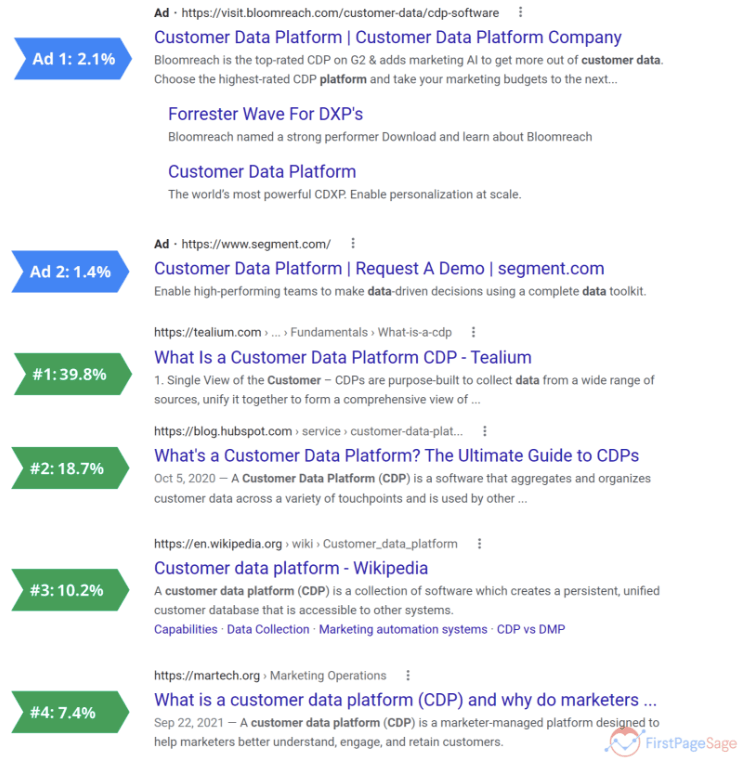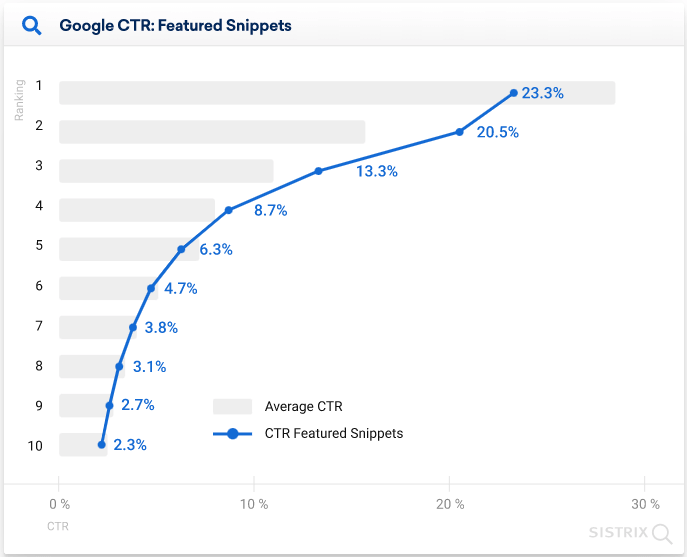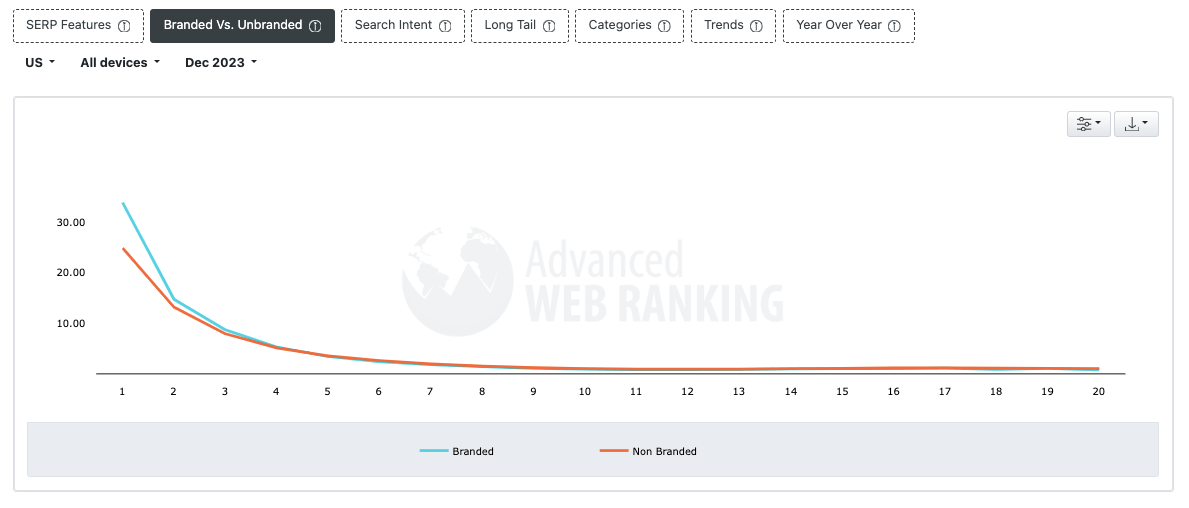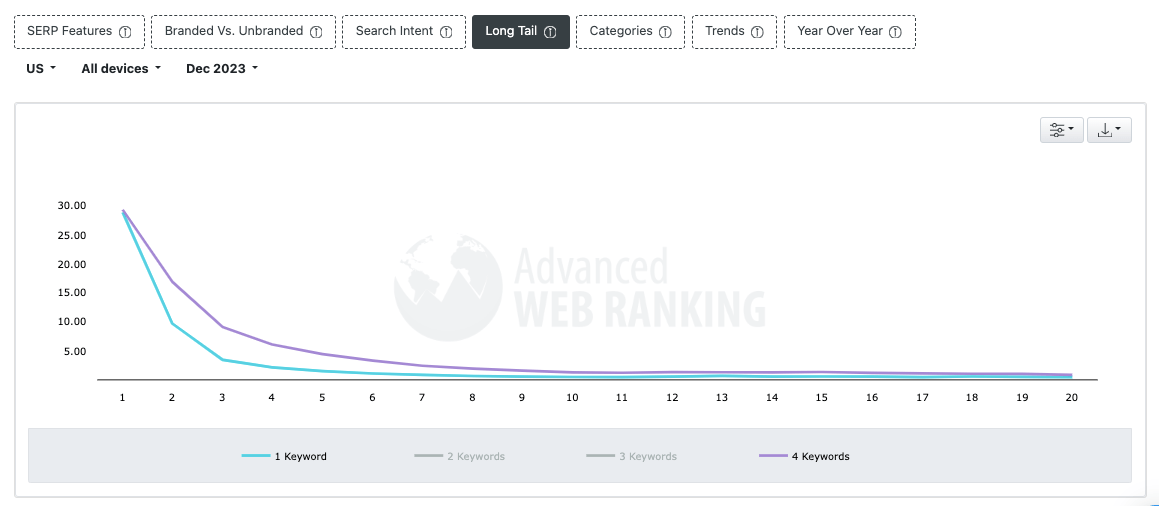Keyword research data reveals the SEO CTR rewards for top of SERP rankings in Google. Inform your SEO marketing strategy with the latest trends in 2024
You often hear company owners saying “I want to rank top” for their target keywords. Although this may be an unrealistic hope, they’re right to say this since they realize that claiming the top position in the SERP (Search Engine Results Page) drives up your SEO click-through rate CTR like nothing else.
October 2023 data from firstpage.com demonstrates that ranking #1 generates a typical CTR of 39.8%. That's more than double the CTR for 2nd position, 18.7%, and nearly 4x the CTR for 3rd position, 10.2%. You can see this example below for example search term 'customer data platform".

While the top 3 positions carry double-digit click-through rates, these start fallling rapidly to only a few clicks per hundred for positions lower down the page. For example, a 4th place ranking would generate approx 7-8% CTR, while positions 9 and 10 typically generate clicks under 2%.
Meanwhile, if ads are served, these perform similarly to organic rankings 8-10, with 1.2% CTR for the 4th ad increasing to to 2.1% for the 1st ad.
You can view the full table of 2024 Click-Through Rates (CTR) by Google Ranking Position below:
| Google Search Feature | CTR |
| Ad Position 1 | 2.1% |
| Ad Position 2 | 1.4% |
| Ad Position 3 | 1.3% |
| Ad Position 4 | 1.2% |
| Search Position 1 | 39.8% |
| Search Position 2 | 18.7% |
| Search Position 3 | 10.2% |
| Search Position 4 | 7.2% |
| Search Position 5 | 5.1% |
| Search Position 6 | 4.4% |
| Search Position 7 | 3.0% |
| Search Position 8 | 2.1% |
| Search Position 9 | 1.9% |
| Search Position 10 | 1.6% |
Savvy marketers understand that establishing a strong organic ranking for your content runs rings around CTRs for paid ads! So, if you're not already, 2024 is the right time to invest in your organic marketing strategy.
Download our Business Resource – SEO gap analysis Excel spreadsheet
This spreadsheet will show you how to create a comprehensive target keyword report and review performance to identify new SEO and content marketing strategies.
Access the SEO gap analysis Excel spreadsheet
SERP layouts vs Safeguarding your organic clickthrough rates
We've all noticed the changing layouts seamlessly integrating into our search journeys. With zero-click searches becoming increasingly common mobile. But what does this mean for our organic reach in 2024? It seems that, for search engine marketers, 'search volume alone isn’t the decisive figure' anymore.
In fact, snippets and panels in 'position zero' take up valuable real estate on the SERP, often at the cost of organic entries beneath. In the chart below, from Sistrix, we can see that when a SERP includes a featured snippet, the SEO CTR for position one drops by an average of 5.3%.

If you are currently defending a top-ranked organic keyword, or would like to increase your reach, why not check to see if there is a featured snippet in the SERP that you could compete for?

Purely organic keyword strategy
That's not to say that purely organic results aren't still your bread and butter. In fact, even in the midst of all these user-friendly innovations, it is still the case that 'the more you work into the long-tail, the greater the proportion of purely organic SERPs'.
Any SEO worth their salt will tell you it's long-tail keyword territory where you can make the biggest incremental gains, We shall be looking into the numbers that still back up this theory in 2023 later in the blog.
So, for your reference (and reassurance), here is the handy table which Sixtrix has produced demonstrating the SEO CTR for a purely organic SERP in blue against the average (across many different formats of SERP).

Keyword SEO CTR uplift - average rankings by SERP position
Depending on your resources, there may be keywords where realistically you aren't competing for the top spot and it's good to acknowledge that - particularly for the more generic terms where competition can get quite fierce.
In this case, studying average clickthrough rates by SERP position is useful since you can estimate uplift in visits with improved visibility rankings. Using the query data from Google Search Console and Search Console Insights will enable you to perform a gap analysis for which keywords to improve in SEO. This exercise will help you prioritize a mammoth task and can also be handy to justify time and resources dedicated to keyword uplift.
The best open source for this data today is the Advanced Web Ranking organic CTR research which we share here, so you can check out the different CTR analysis it gives.
This data is from US traffic on all devices in January 2023. We will look at 3 examples of how CTR varies by position depending on different searcher intent.
1. SEO CTR for brand vs non-branded keyword intent
It's well known that clickthrough rates for the first result on branded or navigational keywords are higher. Generally, non-branded terms will have more competition with paid ads, which show up first on the SERP, which explains the lower organic CTR for non-branded.
This first chart depicts organic CTRs for branded vs non-branded keywords on all devices, globally. Here branded CTRs are selected by AWR when part of the string in the domain name appears in the search indicating a brand name.
The chart clearly shows the value of being in the top 3 keywords, with organic CTRs at 34% and 25% in the first position decreasing to 9% and 8% in the third position. In the lower positions of 11 onwards, CTR has fallen to a paltry sub 1%.

Marketers who have a search term that is monopolized by a particular device may also want to check for device-specific trends.
2. SEO CTR for generic vs long-tail terms
Generic searches for products are typically 1 or 2 words. Long-tail terms are 4 or more. This chart shows a similar pattern of decline to the above, but with long-tail terms receiving higher CTRs.
Here, 4 word SEO techniques outranks generic 1 word searches in positions 2-5 by 6-3 percentage points. Typically this will be because long-tail searches occur further down the sales funnel so users are more discerning at this stage.
Plus, there is less competition (organic and paid) as searches get more niche. So, when considering the ever-evolving SERP layout features, SEOs in 2022 must recognize the benefit of targeting long-tail keywords from their gap analysis.

3. SEO CTR variation based on intent type
We see a similar decline here, but with slight variations according to intent type. For example, comparing commercial intent, we can see a much bigger drop between positions 1 and 2 than other types of intent.
Commercially-minded marketers understand that for targeting those with transactional intent - the best plan is to get your keyword in the top position and keep it there.

4. SEO CTR based on SERP features
We see a similar decline here, but the overriding trend is that SERPS with more features result in a lower CTR for the top organic ranks.
With this knowledge, marketers may want to shift the priorities of their keyword targeting activities, or adjust their content strategy to compete for images/video/featured snippets/people also ask features.

Understanding and applying the latest SEO CTRs in your marketing strategy empowers marketers and managers to review and optimize their paid, owned, and earnt media strategies.
Whatever your focus, we've got resources to help your plan your marketing activities. If you haven't already, why not download our free RACE Growth System template? Use our data-driven structure to create a 90-day action plan tailored to your company's goals.
Create your 90-day plan with the RACE Growth System
Download your free RACE Growth System guide today and unlock our three-step plan of Opportunity, Strategy and Action to grow your business.
Download guide















